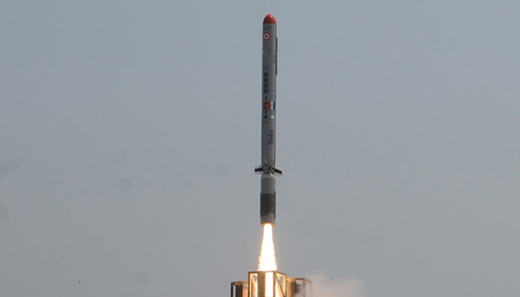1,000 km strike range sub-sonic cruise missile Nirbhay successfully test-fired
Mangalore Today News Network
Apr 15, 2019: India on Monday successfully test-fired 1,000 km strike range sub-sonic cruise missile ’Nirbhay’ off the coast of Odisha. Developed by Bengaluru-based Aeronautical Development Establishment (ADE), a lab under Defence Research and Development Organisation, Nirbhay is a long range, all-weather missile that can be launched from multiple platforms. This sub-sonic cruise missile is capable of carrying conventional and nuclear warheads.

Powered by a solid rocket booster for take off, once Nirbhay reaches the required velocity and height, its further propulsion is managed by a Turbofan engine. An inertial navigation system developed by Research Center Imarat (RCI) gudies this missile, while a radio altimeter is used for height determination.
Nirbhay is equipped with a Ring Laser Gyroscope (RLG) based guidance, control and navigation system. It also comes with a MEMS based Inertial Navigation System (INS) and the GPS system. Measuring 6 metres, the width of Nirbhay missile is 0.52 metres and it has a wing span of 2.7 metres. The weight of this missile is about 1500kg. Experts maintain that Nirbhaya can deliver 24 different types of warheads depending on mission requirements.
The missile has a loitering capability, which allows it to go round a target and perform several manoeuvres and then re-engage it successfully. The Nirbhay missile can select a target among multiple targets and then attack it.The two side wings of Nirbhay missile allows it to fly at different altitudes ranging from 100 m to 4 km above the ground. In times of need, this sub-sonic missile can also fly at low altitudes to avoid detection by enemy radar.
The Nirbhay missle will supplement the role played by Brahmos missile for the armed forces in due course of time by delivering warheads farther than Brahsmos range of 450 km.
Courtesy:Zeenews
- Mangaluru: Commissioner denies misuse of police vehicle during Waqf protest, cites medical emergency
- Belthangady: Autorickshaw overturns near Ujire; driver seriously injured
- Chikkamagaluru: KSRTC driver attempts suicide over alleged harassment by senior officer
- Former don Muthappa Rai’s son injured after being shot at in moving car near Bidadi house
- Mulki: Top portion of Bappanadu temple chariot collapses during Rathotsava; none hurt
- Belthangady youth slips to death in Cauvery river
- Kundapur: Speeding Omni fatally knocks down pedestrian
- Snehalaya and Janamaithri Police launch anti-Drug awareness drive at Uppal and Hosangadi
- Mangaluru: Fight will continue till amendments to Waqf Act are withdrawn, say Muslim leaders
- Direction to remove Janivara would have come with the knowledge of the govt., says Poojary
- JEE (Main) second edition results to be announced by April 19: NTA
- Three arrested for raping woman in Mangaluru, say police
- Summer rush: Special trains, Vande Bharat sleeper announced for Mangaluru
- Honour to speak with PM Modi, will visit India later this year: Elon Musk
- India tears into Yunus regime over Hindu leader’s killing in Bangladesh
- Two homeguards suspended for asking students to remove sacred thread at Shivamogga college
- Caste census report politically motivated, says R Ashoka
- PM Modi to visit Saudi Arabia from April 22-23
- 4 dead, many feared trapped as building collapses in Delhi’s Mustafabad
- Kerala teacher acquitted as student confesses fake rape allegation
- CET officials booked for asking students to remove sacred thread at exam centre in Shivamogga
- BJP worker found hanging in Bengaluru outskirts, video message names ‘local leader’
- CET row: Karnataka govt orders probe after students asked to remove sacred thread
- Man who flashed woman, assaulted 7 people arrested in Bengaluru
- FIR against Sunny Deol, Randeep Hooda for offending Christian religious sentiments in Jaat
- Skills and Competencies Take Center Stage at MSN Dialogue Series
- Court remands Maoist Lakshmi to six-day police custody
- Sandhya Shenoy honored with Society for Materials Chemistry Medal-2024
- White Cornus Apartment in Mangaluru
- City girl wins first place in state-level spell bee competition
- Alleged ‘Love Jihad’ Case in Mangaluru: Woman left home voluntarily, says police
- Girl fatally struck by reckless two-wheeler near Belman
- New residential complex for the judges inaugurated in Mangaluru
- Absconding accused nabbed after 8 years
- Truck with cylinders turns turtle in Beltangady
- Bhoota Kola artist dies of cardiac arrest
- Development of the country should be our goal: Ganesh Karnik
- Container truck gets stuck under Modankap railway bridge
- Truck crushes bike’s pillion rider near BC Road
- Head constable dies of heart attack
- CITY INFORMATION
- TRAVEL
- TOURIST INFORMATION
- HEALTH CARE
- MISCELLANEOUS




 Write Comment
Write Comment E-Mail To a Friend
E-Mail To a Friend Facebook
Facebook Twitter
Twitter  Print
Print 


